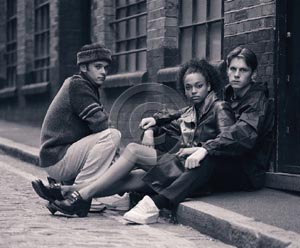WHAT'S WRONG WITH KIDS TODAY?
The teenage Question
Terrie Schauer
When the son swore Diogenes slapped the father.
Oppression is a big word. Once it has been applied to Afrikaans
South Africa or the Sudanese slave-state, we make a travesty of the term if
we apply it to a society as democratic, unbiased and peaceful as our own. Indeed,
to do so strikes one as mockery. Or does it?
 Consider
for a moment the social and legal roles of women before the suffragettes. Not
only were they denied the right to vote and the right to ownership, but, more
importantly, the medical and scientific establishment professed - a view taken
up by popular consciousness - that women were hysterical, irrational, over-emotional
and, thus, unable to bear the weight of responsibility associated with making
their own decisions. As a result, bars, taverns and many social clubs were closed
to the female population. Furthermore, social censorship was imposed on women
who chose to smoke, drink and/or establish themselves as independent. Wanting
a career was unthinkable. Indeed, attempting to seriously enter the political
sphere or to hold anything other than a menial or low-level job, resulted in,
at best, a severe scoffing at.
Consider
for a moment the social and legal roles of women before the suffragettes. Not
only were they denied the right to vote and the right to ownership, but, more
importantly, the medical and scientific establishment professed - a view taken
up by popular consciousness - that women were hysterical, irrational, over-emotional
and, thus, unable to bear the weight of responsibility associated with making
their own decisions. As a result, bars, taverns and many social clubs were closed
to the female population. Furthermore, social censorship was imposed on women
who chose to smoke, drink and/or establish themselves as independent. Wanting
a career was unthinkable. Indeed, attempting to seriously enter the political
sphere or to hold anything other than a menial or low-level job, resulted in,
at best, a severe scoffing at.
Yet this is a well-know story. It shouldn't come as news to
anyone who has even the slightest inkling of Western history.
Why rehash it then? Because we seem not to have learned from
our mistakes.
In contemporary North American society, there is a group that
holds comparable rights and status.
They're on every street corner, in every movie-theater, mall
or video-arcade. You probably speak to them whenever you order a burger from
a fast-food chain or buy a pair of pants from the GAP or the Levi's store. Graffiti,
petty acts of vandalism - you can be pretty sure that they're behind it. When
you sit, safe in your home, reading about the latest rash of high school shootings,
and wonder why anyone would buy the dirty-mouthed, angry music that gets played
on the radio and MTV, or what's wrong with kids today? Stop for a second and
think about oppression.
Why is it, for example, that the teenage suicide rate is higher
than that of any other segment of the population? Why do violence, drugs and
alcoholism affect adolescents more than anyone else?
 Rather
than cite these statistics as proof of teenagers' incapacity to act responsibly,
we should perhaps question what it is that drives them to such lengths. Are
teenagers really unable to handle the vices and trials of the adult world, or
is the impetus perhaps deeper and more insidious than age-related myopia?
Rather
than cite these statistics as proof of teenagers' incapacity to act responsibly,
we should perhaps question what it is that drives them to such lengths. Are
teenagers really unable to handle the vices and trials of the adult world, or
is the impetus perhaps deeper and more insidious than age-related myopia?
Could the issue's crux in fact be North America's inability
to deal with its youth?
I am not suggesting that we eliminate age restrictions or restructure
our pedagogical models or do something as radical as offer kids a hand in determining
their own futures; no, that'd be going too far. Rather, I propose that we take
an honest look at the social conditions that cause teenage disenfranchisement.
The simple fact is this: few avenues exist for young people
to gain validation. Outside of academics and athletics, there are only two domains
of public life in which adolescents can glean peer as well as adult recognition
- consumption and delinquency.
Beyond the clothes they wear and the music they listen to,
modern adolescents lack forums for association and self-expression. Today's
youth is condemned to an obsessive preoccupation with self-image.
Advertising agents have done their demographic research. As
adolescents can only prove their self-worth according to their patterns of consumption,
corporations continue to feed their insecurities. For young women, this means
problems such as anorexia, bulimia - briefly, the full complement of eating
disorders. Young males prove their self-worth by adhering to the consumption
patterns prescribed by a host of semi-delinquent sub-cultures.
Furthermore, kids found spending leisure time outside the confines
of academic, athletic or consumption-based space are seen as a potential problem.
We demonize them as possible criminal elements.
 The right
to free assembly, where adolescents are concerned, is truly a joke. While coffee
shops, when they allow loitering, sports fields and parks, during the day-time,
offer some respite, there are still glaring lacunae when it comes to unathletic
kids and kids with little disposable income. In these cases, few legitimate
activities exist. The sad reality is that there are few channels open for teenage
energy besides 'causing trouble', consumerism and image-creation.
The right
to free assembly, where adolescents are concerned, is truly a joke. While coffee
shops, when they allow loitering, sports fields and parks, during the day-time,
offer some respite, there are still glaring lacunae when it comes to unathletic
kids and kids with little disposable income. In these cases, few legitimate
activities exist. The sad reality is that there are few channels open for teenage
energy besides 'causing trouble', consumerism and image-creation.
European cultural policy has certain limited strategies for
combating such problems. In Ireland, for example, or Bavaria, where the drinking
age is fourteen, something as simple as allowing young people into bars - in
effect giving them the right to assemble - decreases the youth crime-rate.
On this side of the Atlantic, our puritanical governments would
argue that allowing youngsters into bars would precipitate alcoholism and rowdiness.
Not so. We need only compare the behavior of most American college students
with that of the average Bavarian fourteen-year-old. I believe the American
establishment would shudder with embarrassment.
But this isn't the point. While giving kids another forum for
controlled consumption might alleviate some stresses, it certainly doesn't tackle
the problem at its base.
The time has come for the adult community to take responsibility
for the emotional repercussions of its interdictions. We cannot continue to
blame adolescents for their troubles, least of all when it is our rules which
are their direct cause. Taking into account the lack of rights, freedoms and
means of self-actualization available to today's youth, is it any wonder that
so many kids turn to vandalism and petty theft? Is their aggression really a
surprise? What about the host of emotional and psychosomatic problems and disorders?
Are these really the fault of adolescent instability, or are they symptoms of
a larger issue?
It is time for us to stop asking what's wrong with kids. There
is another more pressing question - what's wrong with the way we treat kids
today?
THE END
Voice Your Opinion
- Back to
the Table of Contents - HOME
 Consider
for a moment the social and legal roles of women before the suffragettes. Not
only were they denied the right to vote and the right to ownership, but, more
importantly, the medical and scientific establishment professed - a view taken
up by popular consciousness - that women were hysterical, irrational, over-emotional
and, thus, unable to bear the weight of responsibility associated with making
their own decisions. As a result, bars, taverns and many social clubs were closed
to the female population. Furthermore, social censorship was imposed on women
who chose to smoke, drink and/or establish themselves as independent. Wanting
a career was unthinkable. Indeed, attempting to seriously enter the political
sphere or to hold anything other than a menial or low-level job, resulted in,
at best, a severe scoffing at.
Consider
for a moment the social and legal roles of women before the suffragettes. Not
only were they denied the right to vote and the right to ownership, but, more
importantly, the medical and scientific establishment professed - a view taken
up by popular consciousness - that women were hysterical, irrational, over-emotional
and, thus, unable to bear the weight of responsibility associated with making
their own decisions. As a result, bars, taverns and many social clubs were closed
to the female population. Furthermore, social censorship was imposed on women
who chose to smoke, drink and/or establish themselves as independent. Wanting
a career was unthinkable. Indeed, attempting to seriously enter the political
sphere or to hold anything other than a menial or low-level job, resulted in,
at best, a severe scoffing at. Rather
than cite these statistics as proof of teenagers' incapacity to act responsibly,
we should perhaps question what it is that drives them to such lengths. Are
teenagers really unable to handle the vices and trials of the adult world, or
is the impetus perhaps deeper and more insidious than age-related myopia?
Rather
than cite these statistics as proof of teenagers' incapacity to act responsibly,
we should perhaps question what it is that drives them to such lengths. Are
teenagers really unable to handle the vices and trials of the adult world, or
is the impetus perhaps deeper and more insidious than age-related myopia? The right
to free assembly, where adolescents are concerned, is truly a joke. While coffee
shops, when they allow loitering, sports fields and parks, during the day-time,
offer some respite, there are still glaring lacunae when it comes to unathletic
kids and kids with little disposable income. In these cases, few legitimate
activities exist. The sad reality is that there are few channels open for teenage
energy besides 'causing trouble', consumerism and image-creation.
The right
to free assembly, where adolescents are concerned, is truly a joke. While coffee
shops, when they allow loitering, sports fields and parks, during the day-time,
offer some respite, there are still glaring lacunae when it comes to unathletic
kids and kids with little disposable income. In these cases, few legitimate
activities exist. The sad reality is that there are few channels open for teenage
energy besides 'causing trouble', consumerism and image-creation.